 |
Lori Johnson-Incaviglia Turner and Bella |
Hi, Jean Robb here. This story comes today with a very sad heart. My sweet friends Joseph and Lori Turner had to say goodbye to their little angel Bella today. You see Bella has been fighting for her life for over two weeks now. In all of my years working with animals I HAVE NEVER seen any one fight to stay alive like little Bella. Here's Bella's story. Bella was a beautiful three year old puppy that came into Lori and Joseph's life 2 years ago. This dog started life out in true Bella style. Her momma had a litter of puppies,one of them was a very sick baby.Bella insisted that the momma take care of the sick one. Even as a baby, Bella set the rules and inspired you to not give up and to fight for your place in this world. A few weeks ago Bella went in for her vaccines. What we didn't know was how dangerous it was to give small dogs under ten pounds all of the vaccines at one time. Bella became critical within a day and had to be rushed to the emergency vet. Bella has fought for two weeks and has now helped the vet understand better how to treat dogs with this kind of reaction. The vet and staff did an amazing job watching over Bella and helping her fight but at the end Lori and Joseph gave Bella the greatest gift they could. They helped her give up .They placed her in God's hands and gave her the gift of peace. With broken hearts they want to make sure that Bella didn't die in vain. They want to get the word out and save others from the heartbreak of saying goodbye .Here's some information to share with others.
Vaccinating Small Dogs: Risks Vets Aren’t Revealing
Written by Jan on September 30, 2009 – 12:01 am At
last, a smoking gun … discovered pointing directly at Chihuahuas,
Dachshunds, Maltese, Yorkies and other small dogs … in fact, pointed at
all dogs receiving multiple vaccines during one clinic visit.
At
last, a smoking gun … discovered pointing directly at Chihuahuas,
Dachshunds, Maltese, Yorkies and other small dogs … in fact, pointed at
all dogs receiving multiple vaccines during one clinic visit.Many scientific studies and taskforce reports have altered my view of vaccination over the years, but none have stunned me as much as “Adverse events diagnosed within three days of vaccine administration in dogs” by Drs. Moore, Guptill, Ward, et al. This two-year study of vaccine reactions (from data gathered at 360 Banfield clinics in 2002 and 2003) concluded: “Young adult small-breed neutered dogs that received multiple vaccines per office visit were at greatest risk of a VAAE [Vaccine Associated Adverse Event] within 72 hours after vaccination.” And that’s not all the report revealed.
In the study (published in JAVMA, the Journal of American Veterinary Medical Association in October, 2005), 1.2 million dogs received almost 3.5 million vaccine doses. Reactions reported within 3 days (as designated by computer codes) included nonspecific vaccine reactions, allergic reactions, urticaria (hives), anaphylaxis (severe, whole-body allergic reaction), cardiac arrest, cardiovascular shock and sudden death. For each 10,000 dogs vaccinating, 38 adverse reactions were reported.
You’re probably thinking: just 38 reactions per 10,000 dogs? That’s not too bad. But bear in mind that this study did NOT include:
Factors Increasing The Risk of the Vaccine Adverse Reaction
Body Weight. The reaction rate increased significantly as body weight decreased. That is, small dogs were at greatest risk for a reaction. Risk for dogs weighing 11 pounds or less was 4 times greater than the risk for dogs weighing 99+ pounds. Medium-sized dogs also had increased risk over larger dogs.
For all vaccines and for the rabies vaccine given alone, the reaction rate for dogs weighing 22.2 to 99 lbs. was approximately half the rate of dogs weighing less than 22.0 lbs. Little dogs had 32+ reactions per 10,000; medium-sized dogs, 15+; large dogs, none.
Neutering/Spaying. Neutered dogs had a 27% to 38% greater risk versus sexually intact dogs.
Age. Dogs 1.5 to 2.5 years of age had a 35% to 64% greater risk of reactions (with rates increasing up to 2 years and declining thereafter) than puppies 2 to 9 months old. The risk was least for dogs 6 years of age and older.
Number of vaccines per office visit. The risk significantly increased as the number of vaccines given at each visit increased. In little dogs (under 10 lbs.) each dose increased risks by 27%; in dogs weighing more, each dose increased risk by 12%.
Taking all dogs into consideration, each additional vaccine given at each office visit increased the rate of vaccine reaction by 24.2%. All 3 dogs in the study with recorded deaths had each received 4 or more vaccines at their last office visit.
3 or more vaccines given at once increase the risk of a vaccine reaction 50% over the risk of a single shot. Giving 5 simultaneous vaccines doubles the risk!
Breed. Among breeds with 5,000 or more dogs vaccinated during the study period, the most vaccine reactions per 10,000 dogs were found, in order, in Dachshunds, Pugs, Boston Terriers, Miniature Pinschers and Chihuahuas. Next came Maltese, Miniature Schnausers, Jack Russells, Toy Poodles and Yorkshire Terriers. Mid-size dogs (like Lhasa Apsos, Bichons and Beagles) followed. At the bottom of the list was Chow Chows, German Shepherds and Rottweilers.
Purebred Status. The vaccination reaction rate for mixed-breed dogs was in the bottom fifth of all rates. The researchers state: “safety trials that use such dogs may underestimate the reaction rates that would occur in purebred dogs.”
Why Does a Dog’s Weight Have Such a Big Impact?
The researchers report: “Vaccines, in contrast to virtually all veterinary pharmaceuticals, are prescribed on a 1-dose-fits-all basis, rather than by body weight.”
I have always been shocked that a Chihuahua puppy and an adult Great Dane are given the same dose shot: 1 mL. They get the same volume of virus or bacteria plus the same volume of adjuvants (boosting agents like aluminum), preservatives (like mercury), antibiotics, stabilizers and foreign tissue cultures (like fetal calf serum). All these ingredients are known to cause vaccine reactions. (Learn more about vaccine ingredients at the CDC.)
The study’s researchers go on to say that during a vaccine’s pre-licensing trial, manufacturers investigate the safety of excessive doses of vaccines “but only in a limited number of dogs. The results of this study suggest that trials in dogs that weigh [22 lbs.] underestimate the expected VAAE rate in smaller dogs.”
The risk of a vaccine reaction in this study population was inversely related to a dog’s weight. This weight/response relationship was also suggested by a study in which toy breeds had significantly more reactions than other dogs, although body weight was not evaluated.
How Do You Avoid Reactions to Vaccines?
The study detailed here reports the problems, but not the remedy. They only recommend that veterinarians advise clients of the risks.
Regrettably, I have been unable to find you a link to the study on-line. Your vet may have on-line access if he/she subscribes to JAVMA ( J Am Vet Med Assoc. 2005 Oct 1;227(7):1102-8). You can read a short summary or have your non-subscribing vet request the article for a small fee at http://www.ncbi.nlm.nih.gov/pubmed/16220670 or http://avmajournals.avma.org/doi/abs/10.2460/javma.2005.227.1102?journalCode=javma Note: A smaller study for cats entitled “Adverse events after vaccine administration in cats” turned up similar results to the dog study.
If your vet gives multiple shots in a visit, you should insist that he/she read this study. If your vet has already read it, he/she should explain to you why you weren’t informed of the risks to your dog of multiple shots, especially if your dog was small or medium sized.
Please read my article on Protecting Dogs From Vaccine Reactions for my recommendations for avoiding adverse reactions in all size dogs. Sign up for notification of future articles and our free dog care e-newsletter (delivered quarterly). Follow K9Author at Twitter.
This is an important study. Please bookmark this article and send it to friends.
Related articles:
Combination Shots for Dogs: Weapons of Over-Vaccination
Titer Test: Don’t Vaccinate Your Dog Unnecessarily
Vaccinating Dogs: 10 Steps to Eliminating Unnecessary Shots
Vaccinating Unhealthy Pets: Beware Reactions & Vaccine Failure
Veterinary Advice: Vaccine Side Effects and Risks.
It is uncommon to see problems with the administration of vaccines to our pets, however issues with vaccination can occur and you should be aware of these when planning to have a pet vaccinated. I must stress, however, that although the following problems and vaccine side effects can occur and can even be life threatening, vaccination safety is generally quite high and concerns and fears about the adverse effects of vaccines should not be used as grounds to avoid immunizing your cat or dog. The diseases that we are protecting them from (especially canine parvovirus, canine distemper virus, canine adenovirus or hepatitis virus, feline panleukopenia - otherwise known as feline parvo or, incorrectly, feline distemper - feline leukemia and feline immunodeficiency virus - otherwise known as FIV or feline AIDS) can be far more disastrous than the real risk of a vaccine reaction.
The following article discusses these side effects of vaccination:
1) Sleepy, depressed, inappetent puppies and kittens immediately following vaccination.
2) Irritable, grumpy puppies and kittens that don't like being touched following vaccination.
3) A lump under the skin at the site of injection. 4) Nasal and/or ocular discharge and sneezing following intranasal vaccines. 5) Anaphylactic reactions. 6) Mild allergic reactions - puffy face and ears. 7) Vaccination failures - clinical signs of disease/infection despite vaccination. 8) Feline vaccine associated fibrosarcoma. 9) Lameness in kittens following the calicivirus vaccine. 10) Excessive bleeding at site of injection. 11) Concerns with pilonidal sinuses - caution in giving needles to Rhodesian Ridgebacks. 12) Immune diseases - e.g. Immune Mediated Hemolytic Anemia - following vaccination. Includes information on Serum Sickness. 13) Rabies vaccine reaction: neurological disease following administration of rabies vaccinations. 14) What do I do if my pet has a vaccine side effect?
WARNING - IN THE INTERESTS OF PROVIDING YOU WITH COMPLETE AND DETAILED INFORMATION, THIS SITE DOES CONTAIN MEDICAL AND SURGICAL IMAGES THAT MAY DISTURB SOME READERS.
Commonly Reported Side Effects of Vaccination
Sleepy, depressed, inappetent puppies and kittens:
When I worked at an Emergency Centre, one of the most common calls I used to receive were from people whose kittens or puppies had just been vaccinated and which were now listless and flat-seeming and wanting to sleep a lot. Some of them were reported to feel 'hot to touch' and some of them were also off-food.
This general malaise after vaccination is a common sequelae to immunizing pups and, in particular, kittens (particularly with the Feline Leukemia vaccine) and it occurs because the young body has just had a highly immune-reactive, live virus injected into it (along with other reactive additives, called adjuvants, which enhance the immune response) which the body is now busily trying to fight off. As occurs with any infection that the body is fighting (think of yourself with the flu), it is not uncommon for kittens and puppies to feel off-colour and lethargic, go off their food and even get a fever following immunisation. In my experience, the phenomenon tends to occur most when kittens and puppies have been given a large number of vaccines to fight (e.g. kittens given the full course: feline herpes vaccination, feline calicivirus vaccine, feline panleukopenia immunization, chlamydia immunization, feline leukemia vaccine, feline aids injection and, in some situations, a rabies vaccination as well).
When to worry:
In the first 24 hours after vaccination, I would not worry at seeing these post vaccine symptoms. My suggestion would be to keep the kitten or puppy in a nice warm, quiet place, with plenty of water available (even gently syringing small amounts of water into the mouth to get some liquid into them). Tempt them frequently with warmed, strong-smelling food (e.g. fish or fishy canned food for cats, chicken for puppies) to get them to eat.
If they eat - great. They might be a bit off colour (not as playful or alert) for the next couple of days as they fight the 'infection', but if they are eating and drinking well, then you can all probably ride it out without veterinary attention so long as the animal continues to improve daily. If the young animal will not take food or water, then this is of greater concern. Young kittens and puppies are only small and can dehydrate quickly. My advice is that if the pup or kitten has not picked up and started drinking and eating by 36 hours (at the latest 48 hours), you should seek veterinary advice.
NOTE - Live attenuated vaccines containing Chlamydia can cause signs of fever, lethargy and stiffness for up to three weeks in kittens, following vaccination with these products. It is usually self limiting but pain relief and anti-inflammatories may help to make the kitten more comfortable while the problem resolves itself.
Irritable, grumpy puppies and kittens that dislike being touched:
It is not uncommon for vaccine sites to hurt after vaccination. After all, the injection site of a vaccine is a site where an aggressive immune inflammatory response is taking place and, consequently, the region can be swollen, red and painful. Petting a kitten on the neck or head after vaccination can often elicit a flinch, accompanied by a growl or cry. Owners can be bitten or scratched if they touch the sore vaccination spot. In addition to the pain of the site, these kitties and puppies are often a bit feverish and off-colour: this does not improve their mood!
Remember also, that some of the vaccines are given in the hind legs (right hind leg for rabies vaccination and left hind leg for feline leukemia vaccination). Kittens and puppies injected in a leg will often be painful to touch in these places and may also limp.
When to worry:
In the first 3-5 days, I would not be concerned. If, however, a large lump forms at the site and seems to be getting larger (e.g. an abscess) OR the animal becomes unwell, off food, depressed etc. outside of that initial 24-48 hours immediately after the vaccination, I would see a vet immediately. Injection site infections can occur.
A firm, non-painful lump under the skin at the site of injection:
It is not uncommon, particularly with killed vaccines containing reactive adjuvants (immune system stimulatory additives), to get a lump at the site of vaccination. Generally this lump is under the skin and can be quite mobile. Often somewhere around the size of a pea, right up to the size of a large marble, these vaccine-site-reaction lumps are comprised of a mixture of inflammatory cells (the immune system cells that attacked the injected vaccine) and scar tissue. They may stay the same size for years or can, over time (generally 2-6 weeks), reduce in size. Some will even disappear. In some breeds (e.g. poodle, bichon), these reactions can be associated with dark skin pigmentation and loss of hair at the site of the vaccine. Many veterinarians will vaccinate show dogs in discrete areas (inside the groin, under the point of the shoulder) to avoid vaccine-associated lumps or hairloss being picked up by judges at shows.
When to worry:
If the lump grows very large within the first month of vaccination (particularly if the lump is red and painful or the animal is off colour), I would advise veterinary attention. Not all vaccine lumps are typical vaccines site reactions: abscesses can occur if the vaccine was contaminated with bacteria or if bacteria from the skin was inadvertently pushed under the skin by the vaccine needle. Abscesses need veterinary attention.
Also, if the lump stays one size for ages and then, inexplicably, starts growing in size, I would definitely advise checking this. It is possible for cancers (e.g. feline vaccine associated sarcoma) to form at sites of inflammation, including vaccination inflammation. For this reason, you should make a habit of regularly palpating and noting the size of any lump present on a pet.
Nasal and/or ocular discharge and sneezing:
Live intranasal vaccines including the kennel cough vaccines (parainfluenza virus, Bordetella +/- canine adenovirus) and intranasal cat flu vaccines (feline herpes virus - FHV - and feline calicivirus - FCV) can induce mild signs of the disease that they are designed to prevent, with a watery ocular and nasal discharge and sneezing (occasionally coughing) being the most common signs. These signs tend to develop 3-4 days following intranasal vaccination.
When to worry:
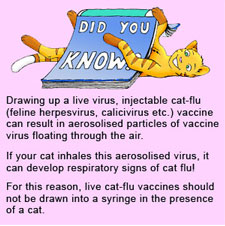 Generally, these symptoms are self limiting and disappear within days. If the
nasal discharge thickens and develops colour, changing from a clear, watery
discharge to a thicker yellow or green discharge, a visit to the vet is warranted. Green
and yellow discharges can be indicative of bacterial infection and antibiotic medication may be needed.
Generally, these symptoms are self limiting and disappear within days. If the
nasal discharge thickens and develops colour, changing from a clear, watery
discharge to a thicker yellow or green discharge, a visit to the vet is warranted. Green
and yellow discharges can be indicative of bacterial infection and antibiotic medication may be needed.
Note that it is possible for cats and dogs showing mild vaccine-induced respiratory symptoms to pass these vaccine viruses on to other cats/dogs in the household, thereby inducing similar mild upper respiratory tract symptoms.
Note that, in populations of cats and dogs with genetic immunodeficiencies (e.g. some purebred animal breeds), the use of intranasal vaccines may need to be avoided becaue of a greater risk of severe upper respiratory signs being induced by nasal vaccinations.
Less common vaccine Side Effects:
Anaphylactic reaction:
Anaphylaxis is a severe, life-threatening allergic reaction that occurs against one or more components of the vaccine. When exposed to the foreign reactants (called antigens and adjuvants) contained in the vaccine, the mast cells of the immune system activate, releasing massive amounts of histamine into the system.
In dogs, this results in acute vomiting and diarrhoea (sometimes containing blood), severe, acute shock, collapse, pale grey/white gums, a rapid heart-rate and low blood pressure. Animals can even 'drop dead' (severe allergic reactions towards vaccines are responsible for many of the vaccine deaths encountered by vets). Swelling of the face and throat can occur, making it very difficult for the dog to breathe. Wheals or 'hives' (raised red patches) can occur over the skin.
In cats, vomiting, diarrhea, sudden collapse and itchiness of the face (+/- swelling of the ears) can occur as they do in dogs. Cats can sometimes get a severe, life-threatening reaction within their lungs, resulting in fluid (and even blood) pooling within their airways. This lung condition may progress despite treatment and result in death of the cat.
Any vaccine has the potential to cause a reaction, however, it should be noted that the killed vaccines (e.g. killed rabies vaccine, FeLV vaccines) are possibly more likely to induce an allergic vaccine reaction than the live vaccines. This is because the killed vaccines often contain large amounts of viral material (they don't replicate in the body so more has to be injected initially) as well as adjuvants (additives that stimulate a better immune reaction) which are both very immunoreactive. Killed bacterial vaccines (termed bacterins) such as the Bordetella injectable vaccines, coronavirus vaccines and leptospira vaccines are also highly reactive and likely to cause allergic reactions.
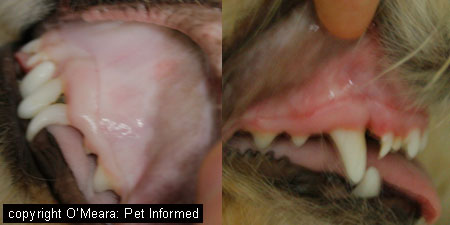
Image of gum colour before and after anaphylaxis treated with antihistamine.
When to worry:
Anaphylaxis is an emergency and must be seen immediately by a vet. Often the reaction occurs in the vet clinic (sometimes within seconds of vaccination) or soon after the animal has left the clinic, although it can take up to 24 hours to manifest (so you should keep a close eye on the animal at home). The vet will usually rush the dog straight out to a treatment room, where it will receive oxygen, IV fluids, anti-histamines, adrenaline, anti-inflammatories and sometimes other drugs to aid in the treating of low blood pressure.
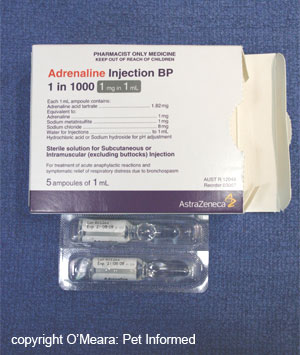
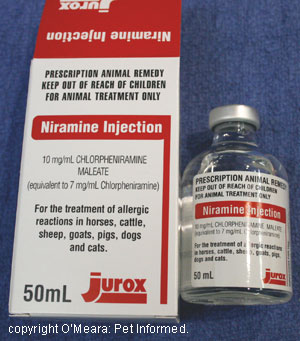
Generally, if a dog or cat survives an anaphylactic reaction, it should be fine. Very old animals that suffer shock reactions may be at risk of developing acute renal failure or other systemic signs due to the drop in blood pressure that occurs and they should be monitored for this over the next 24-48 hours. Pregnant bitches or queens may abort.
The issue is then, do we vaccinate the animal again?
Generally, vets will try to keep the annual vaccinations going in younger animals (under 6-8 years) because of the risk of infection from the viruses if they are unvaccinated and because of the fact that under vaccinated animals (pets that have not received their booster vaccinations) will not be accepted by kennels and catteries.
Generally what happens is that:
1) the vet will premedicate the animal with an antihistamine 5-15 minutes prior to vaccination (to try to reduce the risk of severe reaction). He will rarely use an anti inflammatory such as a corticosteroid, because these products suppress the immune system response, possibly making the vaccine less effective.
2) the veterinarian will vaccinate the animal using either a different brand of vaccine (e.g. change from a CSL vaccine to a Fort Dodge vaccine); a different form of vaccine (e.g. live instead of killed); a different vaccine schedule (e.g. several vaccines over several days to reduce the amount of reactive material being given all at once); a different route of administration of vaccine (e.g. go from an injectable to an intranasal, which is not taken up as rapidly into the body) or some combination of all of these. Use of the new three-yearly vaccines is indicated here because, even if a mild reaction occurs, the dose will not have to be repeated for three years.
3) the vet will then monitor the animal in the clinic for any reaction. You may be required to leave your pet at the vet for a period of time to be watched.
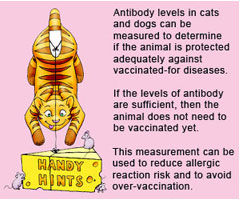 If
the animal is older (over 8 years), the vet may elect to discontinue
the yearly vaccination of the animal (especially if it does not attend
kennels). The older animal is likely to
have built up good immunity towards the main life-threatening diseases
(distemper,
parvo, adenovirus) and will hopefully be fine. The dog will still be
at risk of kennel cough, but an intranasal form of the kennel cough
vaccine could be tried here
instead of the injectable.
If
the animal is older (over 8 years), the vet may elect to discontinue
the yearly vaccination of the animal (especially if it does not attend
kennels). The older animal is likely to
have built up good immunity towards the main life-threatening diseases
(distemper,
parvo, adenovirus) and will hopefully be fine. The dog will still be
at risk of kennel cough, but an intranasal form of the kennel cough
vaccine could be tried here
instead of the injectable.It is possible for some laboratories to measure the level of specific antibodies (proteins in the immune system that recognise viruses in order to trigger immune system defense systems) toward certain infectious organisms, contained in your dog or cat's blood. If antibody levels towards certain organisms are high enough, the animal is considered adequately protected and should not need a vaccine at this time. Antibody measurements can be done on older dogs or younger dogs to assess which vaccines are required. If easily available, these tests should be performed on all animals that have had a vaccination reaction, prior to their next vaccine, so that only the necessary vaccines are given.
How do you know which vaccine caused the reaction?
Since all of the vaccines tend to be given at the one time, it can often be impossible to tell which vaccine was the culprit so you have to careful giving any of them. At the next vaccination, you could consider having the vet give each component a few days apart (where individual virus vaccine products are available) to try to tell which, if any, is the problem. You might potentially find that it is something else (e.g. the heartworm needle) and not the vaccine that caused the problem.
Alternatively, your vet can do an intradermal skin test (0.1ml of each vaccine is administered in the skin) to see which vaccine induces an skin reaction response (a large wheal at the site of injection) as one way of trying to identify the culprit vaccine.
Note that, if the animal has reacted after being given a rabies vaccine, regardless of age you may still be required to vaccinate the dog yearly. This depends on individual state and country laws.
Mild reactions - puffy face and ears:
Sometimes after a vaccination, the animal will not develop a severe anaphylactic reaction, but will show signs of a mild allergic reaction including a puffy face, swollen eyelids, swollen lips and ears (cats especially get puffy ears), itchiness (they'll rub their face and scratch their bodies) and sometimes wheals/hives all over the body. Generally, these animals will not progress to anything nasty, but they will be very uncomfortable - red, hot and itchy. As long as their gum colour remains normal (nice and pink - see image), they show no signs of trouble breathing or wheezing and they are otherwise bright and alert, you may not need to see a vet - the signs will usually abate within a day, sometimes within hours. If the dog is very uncomfortable and distressed from the itching, however, you can see a vet and s/he will check your pet over and give them a dose of an antihistamine. This will speed the onset of normality.
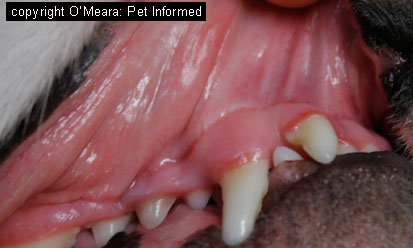
Can I revaccinate my pet after a mild allergic reaction?
In the case of mild reactions and re-vaccinating your pet, one of three things could happen:
A) the animal may have the exact same, mild reaction next time,
B) the animal may have no reaction OR
C) the animal could progress and have a severe anaphylactic reaction and collapse.
I would tend to err on the side of caution and assume that the third option is the likely one. As a result, I would tend to treat subsequent vaccinations with as much caution as I would if the animal's first reaction had been severe anaphylactic. I would take the same precautions for re vaccination (antihistamine premed, try a different vaccine, monitor the animal afterwards etc.)
Vaccination failures - clinical signs of disease despite vaccination:
We will soon link to a whole page dedicated to vaccine failure, but the following is a good, general summary.
Occasionally, vaccines administered by veterinarians will not have the desired prophylactic (preventative) effect and the animal will develop signs of the vaccinated-for disease/s. This can occur for two main reasons:
1) The disease seen is being caused by the vaccine itself:
With some live vaccinations (especially the intra nasal vaccines) it is not uncommon for the animal to develop mild signs of disease: nasal discharge, watery eyes, sneezing. These should, however, be mild and self limiting.
If an animal develops major signs of infection immediately following vaccination with a live attenuated virus vaccine (e.g. a dog develops full-blown parvovirus) then my suspicion would be that the animal had either already been exposed to the wild-type virus around the time of vaccination (i.e. before vaccine immunity was achieved) OR that there was some kind of problem with the animal's own immune system making it unable to fight off the 'mild' vaccine virus strains. It is for this reason that one of the major vaccine contraindications is the use of live vaccines in immune suppressed animals including pregnant bitches/fetuses; very sick animals; animals on chemotherapy and animals on immune suppressant medicines. Infection should not be possible from killed virus vaccines.
2) The disease seen is being caused by a wild-type virus - i.e. a true vaccination failure.
Vaccination failure can occur for many reasons, including:
- the presence of long-lived maternal antibody in the pups, preventing the puppy immune system from being exposed to the vaccine
- a new strain of wild-type virus that is not protected against by the vaccine-induced immunity
- exposing pups to the public (and viruses) before they have finished the full vaccination course and gained immunity
- incorrect vaccination procedures - freezing vaccines, leaving vaccines in the sun, using out-of-date vaccines, not following recommended vaccine protocols, vaccinating febrile or cold animals (e.g. animals under anaesthesia)
- incorrect vaccine administration - not getting intranasal spray vaccines into the nose etc.
- exposure to very large levels of wild-type virus (massive virus loads can overwhelm the immune system)
Rare vaccine side effects:
Feline Vaccine associated fibrosarcoma:
Fibrosarcomas are nasty cancers comprised of mutated, uncontrollably-dividing connective tissue cells that can appear anywhere on the body, including sites of prior vaccination. Occurring at a miniscule rate of 1/1000 to 1/10000 vaccinated cats, anywhere from 2 months to 3-4 years after vaccination (the canine rabies vaccine and feline leukemia vaccine are said to be the main culprits), vaccine associated sarcomas are extremely aggressive, locally invasive tumours that send long 'fingers' of cancer cells out into surrounding tissues. Left untreated, these tumours can invade deeply into the body and wind up killing the cat.
When to worry:
Make a regular habit of palpating the vaccine sites of your cat - don't forget to feel the hind legs as this is where the rabies and feline leukemia vaccines are commonly given. If you feel a lump at an injection site that seems to be enlarging (especially if it develops more than a month after vaccination) or which is greater than 2cm, get it seen by your vet. A good biopsy will diagnose a sarcoma and early and aggressive surgical treatment is often curative.
How do you treat feline vaccination associated sarcoma?
Because connective tissue tumours are generally poorly responsive to chemotherapy (cancer medicines), the best means of treatment of sarcomas is usually excision (cutting it out) sometimes followed up with radiation. Because these tumours tend to be very locally invasive, a radical excision (surgery to cut out the mass) with very wide margins is required to try to get rid of the 'fingers' of cancer cells. If any cancer is left behind, which is likely with large advanced tumours (hence the importance of getting it seen to early), the mass will soon grow back. If the tumour is located on a hind leg, amputation of the leg is often curative - it is for this reason that the rabies and leukemia vaccines (the main cancer culprits) are administered in the hind leg. In some cases where complete excision has been impossible, follow-up treatment with radiation over 3-4 weeks may allow a cat to live for several years.
Prevention of vaccine associated fibrosarcomas:
There is no way to completely prevent these from occurring, short of not vaccinating the cat at all. Note, however, that not giving the vaccine is an option with certain immunisations. Obviously, if you do not live in a rabies-endemic region you probably don't need to vaccinate against rabies (check your local laws though). The same with feline leukemia: a cat that exists 100% indoors with no other cats is very unlikely to ever get feline leukemia virus. With the other core vaccines, although you still need to give them, you can reduce the frequency of vaccination by testing the cat's protective antibody levels to see if a cat needs a vaccine.
If you do need to vaccinate, the risk can be reduced by not giving multiple vaccines in just one site. The more immune stimulation that occurs in one site, the greater the risk of potentially cancerous cell transformation.
The use of live vaccines rather than killed vaccines may be preferable too as the killed vaccines often contain a lot of additives (called adjuvants)which induce an aggressive inflammatory response at the site of injection, possibly leading to neoplasia (cancer). This is of particular concern with the aluminium-containing adjuvants: they should be avoided. There are now non-adjuvant-containing FeLV (feline leukemia) vaccines and rabies vaccines, which may be a lot safer.
You should palpate your cat's injection sites regularly to detect early lump formation.
Vets should give feline leukemia and feline rabies vaccinations in the hind legs (right rabies, left leukemia) so that a leg can be removed should a tumour develop. Also, vaccines should ideally not be given in the scruff of cats (between the shoulderblades) because tumours in this area are tricky to cut out and vaccines tend to pool here, leading to a prolonged, focal reaction against the vaccine in this region. Vaccines should also be given under the skin, not in the muscle, because skin lumps are easier to detect. Vets should also keep a record of the injection sites used (which vaccines are used and where) and keep to this pattern for all subsquent boosters so that recognition of vaccine sites will be much easier.
Intranasal vaccines, where available, should be used in place of injectable vaccines as they are not as implicated in the formation of vaccine sarcomas.
Note - fibrosarcomas are not the only type of cancer that can occur at a vaccine site. Tumours comprising bone cells (osteosarcomas), muscle cells (rhabdomyosarcomas), cartilage cells (chondrosarcomas) and many other cell types have been found.
Lameness in kittens after the calicivirus (FCV) vaccination:
Feline calicivirus is well known as a cause of 'cat flu' symptoms - sneezing, eye discharges, nasal discharges and mouth and tongue ulcers. Less commonly, the virus also affects the bones and joints of the kitten, causing joint swelling, joint pain, muscle soreness and fever. They often limp and they resent having the limbs handled or palpated. The symptoms generally resolve in 2-4 days without any medication. The reason that this information has been placed in the vaccination side effects section is that, sometimes, the live feline calicivirus vaccine can induce the same self-limiting 'limping kitten' signs generally within 1-3 weeks after vaccination.
When to worry:
Any kitten that is feverish, lethargic, inappetent and lame in multiple limbs should be examined by a vet. If it is due to the calicivirus vaccine, good news: it will generally resolve within 4 days without any need for medicine (though fluids, pain-relief and antibiotics can be provided to support them), but I would still advise getting the kitten checked over because there are other nasty illnesses (e.g. immune polyarthritis) that can present with similar signs.
Excessive bleeding at site of needle or vaccination:
It is not common, but I have encountered cases where a dog or cat is given a needle (any type of needle, including a vaccine) and then keeps on bleeding from the site of injection. A huge bruise or blood-filled lump (called a hematoma) may even develop on the skin at the injection site.
These cases are not normal and are not an effect of the vaccination needle or administration of vaccines per se. Generally what happens is that the animal has an underlying bleeding disorder (the animal can not clot its blood) that was unknown before the vet stuck the needle in. Common causes include: rodenticide poisoning (the animal has eaten rat or rabbit poison); human anti coagulant consumption (the animal has eaten the owner's warfarin), blood platelet deficiencies (e.g. immune system attack on the platelets) or congenital bleeding disorders (hemophilia, von willebrand's disease).
When to worry:
Any injection site or cut that does not stop bleeding or that bruises excessively is cause for concern. Animals with normal blood clotting abilities do not do this! Your vet needs to check for an underlying bleeding disorder.
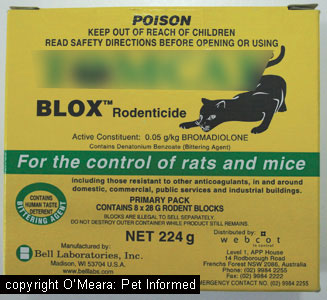
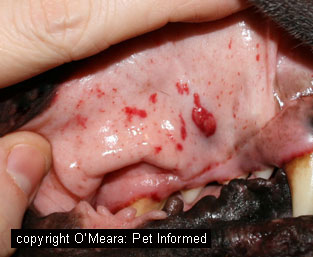
Image 1: rodenticide poison. Image 2: bruising on the gums caused by platelet deficiency
Rhodesian Ridge back or Rhodesian crossbreds - issue with injecting into pilonidal sinuses:
At university, it was drummed into us to never inject along the ridge of a ridge back - or any breed with the ridge along its back, in case the dog had a pilonidal sinus. A pilonidal sinus is a birth defect present in the ridge back and some other breeds whereby the skin and spinal canal of the embryo do not completely separate from each other in utero, resulting in a narrow passage lined with skin cells remaining between the skin and the spinal canal. The skin cells in the passage can make hair or skin flakes (dander) which can extrude out through a hole in the skin surface. In most animals, this is not a clinical problem: owners learn to express and clean the area that the debris comes out of, but in some animals the sinus is a major issue, resulting in abscessation (infection which can impinge on the spine) and neurological signs. The issue with vaccination or any needle for that matter comes if someone accidentally injects substances into the sinus. Since the pilonidal sinus communicates with the spinal canal, injections into the 'ridge' can potentially result in injection fluid leeching down into the spine. This has the potential to cause neurological damage, infection or even death (depending on the stuff injected).
How to avoid it: Don't inject ridge back or ridge back cross breds anywhere along the dorsal body, particularly within the ridge and even more particularly within the 'whorls' of the ridge (as these whorls are often where the sinus exits the body).
Immune mediated hemolytic anemia (and other immune diseases) following vaccination:
Immune mediated hemolytic anemia is a severe, life-threatening disease whereby the immune system targets and destroys the red blood cells of the body, resulting in anemia, jaundice (yellow gums), pale gums, weakness and sometimes fever. Animals can be so severely anemic that they need blood transfusions to stay alive and some may die as a result of anemia and lack of oxygen to tissues or as a result of blood clots entering the lungs, brain or kidneys (ruptured red blood cell membranes float around causing clots to form). These animals are sometimes very sick and in need of special veterinary care and immune-suppressive medications in order to recover. Some will not recover despite what we do.
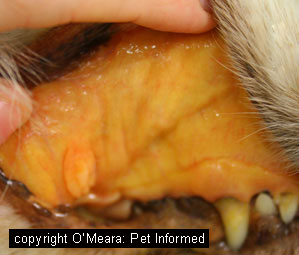
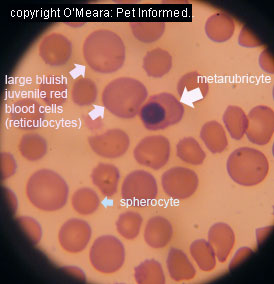
Image 1: yellow, pale gums typical of severe IMHA, Image 2: blood smear from dog with IMHA,
Shortly, Pet Informed will be bringing you a whole series on immune mediated hemolytic anemia and its treatment, as it is one of the more common serious disease issues encountered in the dog or cat. The reason I have included mention of it here is that there are many reasons why the immune system gets triggered to attack the body's red blood cells (or other organ systems - e.g. joint, kidney) and one of these causative factors is thought to be vaccination. For some reason, vaccines can sensitise the immune system in such a way that the immune system gets confused and starts attacking cells of the body.
When to worry:
Any dog with pale or yellow gums must be seen by a vet. These signs will often be accompanied by variable signs of lethargy (tiredness), low exercise tolerance, collapse, dark coloured urine (the urine is often deep yellow, red - the colour of port wine - or brown), heavy or rapid breathing and sometimes inappetence and fever.
Aside from attack on the red blood cells, vaccination can potentially induce the immune system to mistakenly attack other cells in the body, resulting in other immune-mediated diseases besides hemolytic anemia. Example 1: the immune system could be triggered to attack the blood platelets, resulting in a reduced ability to clot the blood and widespread bruising and bleeding within the body. Example 2: the immune system can attack the nerves supplying muscles of the limbs and head (this is termed polyradiculoneuritis or Coonhound paralysis) resulting in flaccid paralysis (a floppy dog) and wasting of the muscles that can progress to affect the dog's ability to breathe and swallow. The affected dog may require months of supportive care (including ventilation and tube-feeding) to recover. See the next section on rabies reactions for more information on polyradiculoneuritis - although it can potentially occur with any vaccine, the condition is particularly associated with the rabies vaccines.
Vaccine-induced Serum Sickness - a rare form of immune-mediated disease: Sometimes, instead of the immune system being 'tricked' into attacking the body's own cells, it is possible for vaccines to induce 'immune disease' by virtue of where antibody/vaccine-virus-antigen complexes decide to deposit themselves.
When a vaccine antigen (the virus protein and/or vaccine additive that the immune system is meant to recognise and attack) is injected into the body, it gets recognised by immune system antibodies. These antibodies bind to the antigen (this binding of antibodies to antigen is called an immune complex) and then, through a series of cell reactions, call other immune system cells over to attack the antigen. This is how an antigen (e.g. an infectious virus) gets destroyed by the body so that it can't cause disease: it is a natural process and vital to the survival of an animal.
Where it all goes wrong: sometimes immune complexes float through the body and get deposited in narrow blood vessels. These narrow vessels are particularly numerous in areas of the body such as the joints, brain, kidney and retina (back of the eye). When the antibodies contained in the immune complexes call the inflammatory cells over to 'kill' the antigens, this immune attack takes place inside these fragile, narrow vessels, resulting in injury of these vessels and their associated organs. Termed serum sickness, this phenomenon can result in painful inflammation and swelling of the joints (called polyarthritis), inflammation and damage to the eye (called uveitis), inflammation and injury of the kidneys (especially the kidney blood-filtering regions called glomeruli) and potentially damage to numerous other organs. Death is possible.
Note - Some Akita lines show signs of multiple-organ immune-mediated disease (including polyarthritis, fever, non-regenerative anemia, renal damage and liver injury) generally within 1 month of vaccination. These dogs often need lots of immune-suppressant drugs to treat the condition and many will die from progressive renal failure.
Rabies Vaccine Reaction: Neurological disease following administration of rabies vaccinations:
It is possible for a dog or cat to develop vaccine-induced form of rabies 10-21 days after receiving a live virus rabies vaccine.
In dogs, one of two things may happen:
The dog could develop a flaccid paralysis of the limbs (a floppy dog) which mimics other diseases like tick paralysis, botulism, snakebite and organophosphate toxicity in appearance, but which is closest in nature to the disease Coonhound paralysis: an immune attack on the nerves supplying muscles of the body, such that the animal is paralysed. (Note the similarity between this and the previous section - immune system attack on red blood cells caused by vaccination - the immune system can be overly sensitive to vaccines). These rabies-vaccinated animals, if supported well for up to 3 months (e.g. nutritional support, possible ventilatory support) may get better.
Rabies vaccinated dogs can also get a severe infection of the brain and spinal cord (called encephalomyelitis) which mimics the rabies disease itself. Any part of the nervous system can be affected and so neurological signs can be very variable. This condition will progress and there is no cure.
In cats (and also some dogs), what is encountered is a flaccid paralysis starting at the leg in which the vaccine was given. This progresses to the other hind leg (cat ends up dragging the hind legs) before eventually involving the forelegs (cats show rigid stiffness of the limbs) as well as the brain (cat shows dementia). There is not cure for this progression and the cat will either die or need to be euthanased.
How do we prevent this?
The vaccine-associated rabies does not seem to occur with the killed / inactivated vaccine, only the live vaccines (live attenuated vaccine), so prevention is possible by using killed vaccines.
What Do I Do If My Animal Has a Reaction?
If an animal has a reaction from a vaccine, it is a good idea to always notify your vet of the problem, even if it is just one of the mild self-limiting reactions noted in the above sections. This way, your vet can report it on your pet's clinic notes so that future vets are aware of the possibility of there being a problem. With issues like severe anaphylactic reactions, clinic notes that make other vets and nurses aware of the risks of vaccination exposure could well save your pet.
Any time that you take your pet to the vet in the future (especially if the veterinarian that you see is not your normal vet) you should remind them of the dangers of vaccinating your pet.
The vet should also notify the maker of the vaccine (vaccine manufacturer) about the reaction so that the company has feedback about their vaccines. Drug companies are generally very responsible and they use this kind of information to troubleshoot and improve upon their vaccines. The vet will notify the company of the batch-number of the vaccine (a label that appears on your vaccine certificate - see image). If a company gets a lot of complaints about a particular batch, they might even recall it, saving other pets from being given a potentially dangerous vaccine.
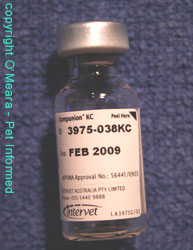
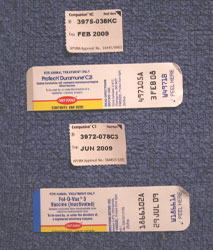
Summary of Vaccination Risks and dangers - Take Home Messages:
Vaccination reactions and illnesses can occur but, as they are uncommon, the fear of a reaction (unless it actually occurs) should not be reason enough to avoid vaccinating dogs and cats. The diseases that we are protecting animals from can often be far worse than the miniscule chance that a vaccine reaction or side effect will occur: the benefits of vaccinations do outweigh the vaccination risks.
It is common for puppies and kittens to be a bit sleepy, grumpy and lethargic the day or two after vaccination.
Make a habit of palpating vaccination sites regularly for any lumps that form and, if these lumps seem to be growing, seek veterinary attention.
Rabies and feline leukemia vaccines are the ones most implicated in vaccine associated sarcomas and should be given at separate sites in the hind legs.
Vaccines sometimes stimulate the immune system excessively, causing the immune system to attack cells of the body. Disease situations such as immune mediated hemolytic anaemia (IMHA), immune mediated thrombocytopenia (IMT or ITP), polyradiculoneuritis (Coonhound paralysis or vaccine-associated-rabies), polyarthritis (joint inflammation) and many others can result.
Report any vaccine reactions or side effects to your vet.
To go from Vaccine Side Effects page to Home Page, click here.
References and Suggested Readings:
1) Encephalitis, Myelitis, and Meningitis. In Nelson RW, Couto CG, editors: Small Animal Internal Medicine, Sydney, 1998, Mosby Inc.
2)Fenner WR, Diseases of the Brain. In Ettinger SJ, Feldman EC, editors: Textbook of Veterinary Internal Medicine, Sydney, 2000, WB Saunders Company.
3) Wolf AM, Other Feline Viral Diseases. In Ettinger SJ, Feldman EC, editors: Textbook of Veterinary Internal Medicine, Sydney, 2000, WB Saunders Company.
4) Kraegel SA, Vaccine-Induced Sarcoma in Cats. In Ettinger SJ, Feldman EC, editors: Textbook of Veterinary Internal Medicine, Sydney, 2000, WB Saunders Company.
5) White RAS, Surgical Treatment of Specific Skin Disorders. In Slatter D, editor: Textbook of Small Animal Surgery, Philadelphia, 2003, Saunders.
6) Greene CE, Schultz RD, Immunoprophylaxis. In Greene CE, editor: Infectious Diseases of the Dog and Cat. St. Louis, 2006, Saunders Elsevier.
Article copyright Pet Informed (TM): February 2008.
All rights reserved, protected under Australian copyright. No images or graphics on this Pet Informed website may be used without written permission of their owner, Dr. Shauna O'Meara.
Protech, Duramune, Fort Dodge and Fel-O-Vax are registered trademarks of Wyeth and its affiliates.
Nobivac and Companion are registered trademarks of Intervet.
Adrenaline Injection BP is a product of AstraZeneca.
Niramine is a registered trademark of Jurox.
Tomcat and Blox are registered trademarks of Bell Laboratories Inc.
Any dose rates mentioned on these pages should be confirmed by a vet. Dosing rates for common drugs are being changed and updated all the time (e.g. as new research comes in and as drug formulations change) and information here may not remain current for long. What's more, although we try very hard to maintain the accuracy of our information, typos and oversights do occur. Please check with your vet before dosing any pet any medication or drug.
About Dr. Shawn
 Dr. Shawn Messonnier, DVM
Dr. Shawn Messonnier, DVMDr. Messonnier, a 1987 graduate of Texas A&M College of Veterinary Medicine, opened Paws & Claws Animal Hospital in 1991. His special interests include exotic pets, dermatology, cancer, and internal medicine. Dr. Messonnier is a well-known speaker and author. In addition to serving clients, he has written for numerous veterinary and pet publications including Animal Wellness, Body + Soul, Veterinary Forum, Dog Fancy, Cat Fancy, Dog World, Fido Friendly, Whole Dog Journal, Whole Cat Journal, Whole Living, Total Health and Wellness.

Fundraising for Pet Charities
I am honored to serve as the medical consultant for Pet-Togethers, a pet supplement company and manufacturer of the popular Vim & Vigor pet supplement. An important part of the company’s philosophy is to give back to the pet community. They do this by working with pet charities and donating a portion of the sales of their products.If you are associated with a pet charity, shelter rescue, etc... I’d like to invite to you allow us to help in your fundraising efforts.
Please contact me at shawnvet@sbcglobal.net and I will follow-up with a phone call to tell you more about our company and how we might work together to raise funds for your group.
Shawn Messonnier DVM
P.S.
In the interim, check out our Vim & Vigor supplement at www.petcentrx.com
FAQs (Frequently Asked Questions)
- What is holistic care?
- Which complementary therapy works best?
- Are there any medications my pet should avoid?
- How often should my pet be vaccinated?
- How effective is nutritional supplementation?
- What is the best diet for my pet?
- What annual care do you recommend for dogs and cats?
- How can I learn more about natural, holistic therapies for my pet?
When I speak or write about holistic care, I'm referring to the "whole" pet. In other words, what is best for the whole pet? Too many doctors focus on just the specific problem at hand, trying to treat a specific problem rather than treat the whole pet or prevent disease.Holistic care looks at the whole pet, including diet, nutritional supplements, preventive care, parasite control, grooming, and exercise. We don't overlook the whole pet and just focus in on one disease. Likewise, we don't neglect conventional therapies when they are indicated. If a pet needs surgery or a medication to get better, we can use these treatments. If the pet is better served with a complementary therapy, or a combination of conventional and complementary therapies, we take this approach. Holistic means being open-minded to what is in the best interest of the pet. By combining both conventional therapies and complementary therapies such as acupuncture, herbal medicine, nutritional supplementation, and homeopathy, we can help the pet heal itself and stay healthy.
There is no one correct complementary therapy. Sometimes acupuncture is best, other times herbal therapy may work better. All pets can benefit from healthy diets and proper nutritional supplementation. By considering the specific needs of the pet, we can fashion a treatment plan from all of the different therapies to help heal the pet.
That depends upon a number of factors, including your pet's age, nutritional status, and overall health. A better question would be to ask, "Which medications might not be necessary for my pet?" For many pets, complementary therapies may replace potentially harmful medications like antibiotics, corticosteroids ("steroids") and non-steroidal drugs like Rimadyl® . That's not to say these drugs can't be safely used when indicated. I only mean to imply that they are among the medications most frequently over-prescribed, overused, and overabused. In many instances complementary therapies can be more safely used as we attempt to wean the pet off of these more potent medications.
Despite many "experts" now offering their opinions, the best answer is that your pet should be immunized AS LITTLE AS POSSIBLE! By running a simple blood test called a vaccine titer, we can determine how often each individual pet needs immunizations. These simple and inexpensive blood tests are easily run by any veterinarian and give you a picture of the status of your pet's immune system. Using this information, your doctor can come up with an immunization plan that's right for your pet. In most cases, a pet only needs to be vaccinated a few times in his life!
Very effective! All pets can benefit from improved nutrition, which helps reduce disease and improve overall health. Many of my patients show improvement just by improving the nutritional status through the use of natural supplements.
This depends upon a number of factors. As a rule, the more natural, chemical-free the diet, the better. Diets full of chemicals and preservatives often lead to increased health problems in our pets. Diets full of inexpensive fillers such as plant and animal by-products are also less desirable than healthier, more natural diets. Learn to read pet food labels so you can tell if your pet's diet is really as healthy as you think!
At minimum, a full physical examination every 12 months and an annual blood profile are needed for pets under 5 years of age. Pets 5 years of age and older should be checked at least every 6 months. These visits are designed to allow early detection of disease. Detecting diseases early, BEFORE YOUR PET BECOMES ILL, allows us to help your pet and decrease the cost of pet care. Vaccinations are RARELY NEEDED and are administered based on titer results (see #4. above.)
In response to the great need for information on holistic therapies, I created the Pet Care Naturally web site. We serve as your #1 source for holistic pet care. Read any of my recommended books to learn more about natural care for yourself and your pet including my award-winning book, The Natural Health Bible for Dogs & Cats. Also, listen to my award-winning radio show each week and sign up for my Yahoo! Group to receive my FREE weekly newsletter, discuss health related issues with others and keep up with what's happening in the world of natural pet care!
Contact Us
To minimize any inconvenience, we request that you schedule an appointment. Thank you.







very good
ReplyDeleteI Never believed that i was ever going to be HERPES Negative again, DR IMONAH have given me reasons to be happy and to live again , My name is JODY BEAVERS from(U.S.A) , i was HERPES positive for 4years and all the means i tried for treatment was not helpful to me , but when i came on the Internet for some research i saw great testimony about DR IMONAH on how he was able to cure people from (Herpes) and also (HEPATITIS B), this people said great things about this man, and advice we contact him for any Disease problem that DR IMONAH can be of help to our problems, well i decided to give him a try, he requested for my information which i sent to him, and he told me he was going to prepare for me a healing portion, which he wanted me to take for days, and after which i should go back to the hospital for check up, well after taking all the treatment sent to me by DR IMONAH, i went back to the Hospital for check up, and now i have been confirm HERPES Negative, friends you can reach DR IMONAH on any treatment for any Disease he is the one only i can show you all up to met for your solution cause he is the permanent savor and healer , reach him now on his via mail at:(drimonahspiritualtemple@yahoo.com) he is there waiting to help you All
DeleteThanks for sharing info. Keep up the good work...We hope you will visit our blog often as we discuss topics of interest to you
ReplyDeleteDogs
It's really a nice and helpful piece of information. I am glad that you shared this helpful info with us. Please keep us informed like this.
ReplyDeleteenglish labrador retriever
You got a really useful blog I have been here reading for about half an hour. I am a newbie and your post is valuable for me.
ReplyDeletePanther having his breakfast
It's really cool and valuable blog with interesting information about the pets.nice job.
ReplyDeleteLittlest Pet Shop Fashems
Nice blog and your all presenting information are very great and it's really good well done.
ReplyDeletedog walker
I have been reading your posts regularly which is specially for dog sites .I need to say that you are doing a fantastic work. Please keep it up the great work.
ReplyDeletedog sites
Very informative article which is about the Dog accessories store and i must bookmark it, keep posting interesting articles.
ReplyDeleteDog accessories store
Very informative article which is about the Pet cbd and i must bookmark it, keep posting interesting articles.
ReplyDeletePet cbd
Your Post is very useful, I am truly to this blog which is specially design about the pet products It helped me with ocean of awareness so I really appreciate your blog.
ReplyDeletepet products
Valuable information in your blog and I really appreciate your work and keep it up dude I really very informative blog about the dogs well done.
ReplyDeletedogs
This is so amazing and all your information about the dog car and i will appreciate it.
ReplyDeleteDog shampoo
I agree with your all information about the vegetarian and animals just keep it up.
ReplyDeletevegetarian
Amazing article & helpful post, Thanks for sharing. bluff downs
ReplyDeleteThis comment has been removed by the author.
ReplyDeleteSuch an amazing blog about the Cannabis CBD Oil and I really appreciate you work which you have done well.
ReplyDeleteCannabis CBD Oil UK
You have really selected the suitable topic; this is one of my favorite blogs.
ReplyDeleteAnimals & Pets